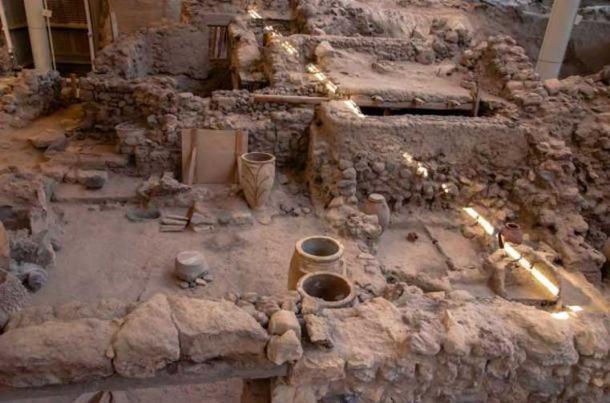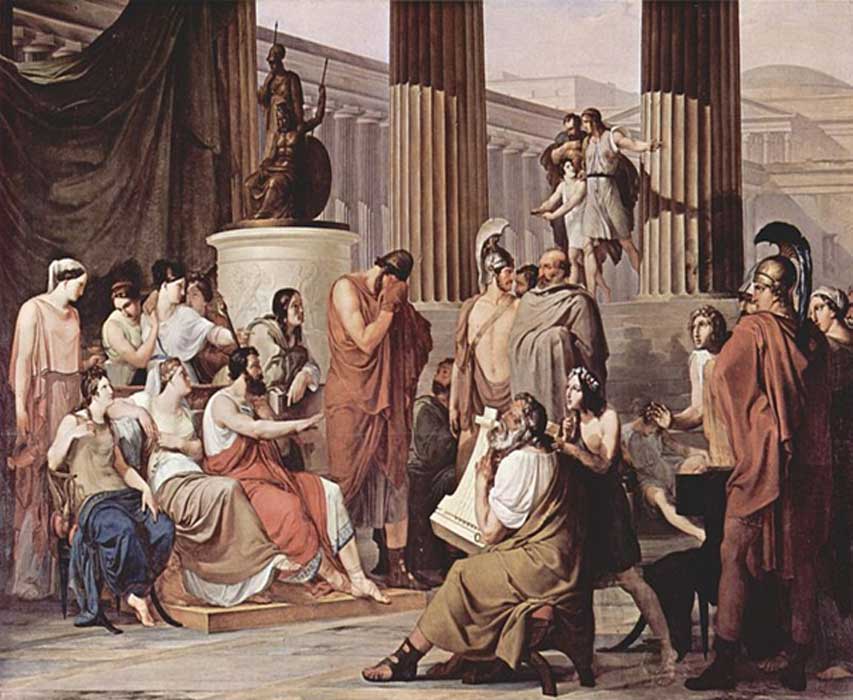In Search of King Alcinous: Who were the Legendary Phaeacians?
The mythological Alcinous and his kingdom have remained one of the most mysterious and elusive topics of ancient Greek literature. Not much is known of this foreign monarch, or at least not much has survived the test of time. Details of the ruler and his kingdom survive only in the journeys of both Odysseus and Jason, but do those details reflect a now perverted form of reality? Was there an Alcinous prototype ruling over a foreign nation of master seafarers? How much evidence can the ancient narratives provide, and how much of it can be corroborated by archaeology and geography?
Literary Evidence
In every source, it is said Alcinous was not a native to Greece but instead a ruler of the peoples known as the Phaeacians, living in the outskirts of what then was the known world. He was a wise and just leader; favored by both gods and man. We are first introduced to him in the eighth century BC epic, the Odyssey.
It is written that under the direction of the Olympians, and after twenty years away from Ithaca, his native land, Odysseus was freed by Calypso (daughter of Atlas the Titan) from her island, and he eventually washed ashore on the island of Scheria. Remember, ten years was taken from Odysseus for the Trojan War while the remaining ten were for his voyage back from the war. Alcinous was the happy ruler of Scheria with his wife, Arete, his five sons and one daughter, Nausicaa.
...but Athene went to the land and city of the Phaeacians. These dwelt of old in spacious Hypereia near the Cyclopes, men overweening in pride who plundered them continually and were mightier than they. From there Nausithous, the godlike, had removed them, and led and settled them in Scheria far from the bread-eating mankind.
...Alcinous was now king, made wise in counsel by the gods.
Homer, Odyssey, vi. 2-12

In legend, naked Odysseus surprises Alcinous’ daughter Nausicaa and her maids. (Public Domain)
Homer spent little time in describing the island itself and instead focused on the palace of Alcinous and the way in which he received and entertained Odysseus. While Alcinous treated his guest to the finest Scheria has to offer, Odysseus shared his woeful and often challenging tale with his Phaeacian audience.
The only clues we are given of the Phaeacians and their island is that it was a mountainous island and they were masters of the sea. With a description like ‘mountainous’, it is no wonder that the location of Scheria continues to elude all in search of it.
We also find Alcinous and the Phaeacians in the Argonautica. Written by the third century BCE author and poet Apollonius Rhodius, we read:
There is a fertile, expansive island at the entrance of the Ionian strait in the Ceraunian sea, under which is said to lie the sickle…
of the Phaeacians has been called by the name Drepane…
the Argo came, aided by the winds, from the Thrinacian sea…
Alcinous and his people gladly welcomed the travelers...
Apollonius Rhodius, Argonautica, iv. 982-997.
The Ceraunian Sea is located just North of the Ionian straight, opening up to the island of Kerkyra (or Corfu). Based on the description provided by Apollonius, Drepane would be associated with Kerkyra.
On the seventh day they left Drepane…
Already they had left behind the gulf named for the Ambracians, already with sails spread wide they had passed the land of the Curetes and the line of narrow islands along with the Echinades themselves.
Apollonius Rhodius, Argonautica, iv. 1223-1230.
His identification of Kerkyra is further confirmed by the voyage following Jason’s departure of the island.

Map showing the route taken by the Argo as detailed in the Argonautica. (CC BY-SA 4.0)
The Ambracian Gulf was situated along the Ionian Sea. It is South of Kerkyra and North of the island of Lefkada, and on the Greek mainland. The Curetes were a legendary people living along and on the islands of Acarnania. Also, situated along the western coast of the Greek mainland in the Ionian Sea.
After skirting the island of Thrinacia, which held the cattle of the Sun, they came to the island of the Phaeacians, Corcyra, which was ruled by Alcinous.
Apollodorus, Library, i. 9
Additional clues may come from the etymology of the word Phaeacian. It is generally accepted that name derives from the Greek phaios or “gray.” While the color may somehow describe the Phaeacian culture, we are still left speculating its true symbolic purpose. Was it their skin color, eye color, the landscape of their island, or something entirely different?
- The Mythic Scheria and the legendary Phaeacians
- The ancient settlement of Akrotiri and the mass exodus of Therans
- Identifying the Teresh of The Sea Peoples

Odysseus departs from the Land of the Phaeacians. (Public Domain)
Historical Evidence

A satellite image of the Ionian Sea.
The earliest reference to Kerkyra dates back to the 13th century BC. The Mycenaean Linear B inscription refers to a ko-ro-ku-ra-i-jo or “man from Kerkyra.” It is difficult to say who inhabited the island during the Late Bronze and very Early Iron ages of the Eastern Mediterranean but we do know that by the eighth century BC, Corinthians and Eretrians (from Euboea) had migrated to the region and settled it.
In every narrative, the land of the Phaeacians was reached after passing the island of Thrinacia in the West. What was Thrinacia? Scholars have long debated this but most tend to agree with ancient sources in identifying it as the island of Sicily. We first read of Thrinacia in Book XII of the Odyssey. It is an island home to the cattle of Helios, the Greek god of the sun. It is strongly believed that part of the name, Thri, resembles the Greek word of tria or three and alludes to the three corners of the island.
The interesting part of all of this is there actually exists a Drepani today. More appropriately called Trapani, it rests on the western coast of the island of Sicily. Its name would have likely been a common one, translating to “sickle”, and based on the curved shape of the city’s harbor. (Refer to the first excerpt of Apollonius Rhodius highlighted above). The site was originally founded by the Elymians during the Classical Period, that is, from the 5th to 4th centuries BC.

Photo of modern-day Trapani with its curved, sickle-shaped harbor. (CC BY-SA 3.0)
Does History Reveal Answers?
Homer’s epic recalls an age long forgotten, and one that predates the Greeks of his time. It was a time of heroes and epic adventures. It was also a time hosting both miraculous and fearful mythological gods and creatures. Modern scholars place this timeframe in and around the end of the Late Bronze Age, circa 1200 BC. What followed this era was a brief Dark Age; literacy disappeared and legends were born. With this in mind, can we, without a shred of doubt, place the Phaeacians on the Greek island of Kerkyra? Unfortunately, the answer is a firm no. At least, not until additional archaeological or literary evidence proves otherwise.
We have yet to understand the role of Kerkyra in the world of the Mycenaean Greeks. Were they non-Greek-speaking outsiders? Were they experts of the sea? Despite what has been maintained through Classical tradition, this conclusion does raise its fair share of doubts. For instance, Kerkyra is to the North of Ithaca in the same Ionian Sea. When Alcinous received Odysseus into his palace, they admit to not knowing Odysseus the man, but instead knew of Odysseus the hero of the Trojan War, as evidenced by the bardic tales of Demodocus.
How could two influential kings (i.e. Alcinous and Odysseus) share dominion in the same sea and not personally know the other?
Did the Phaeacians exist beyond Greece and further west closer to the Italian mainland? Does the Sicilian Trapani in any way relate to the Drepani of the Phaeacians? Probably not. As I highlighted earlier, the name itself would have been representative of the landscape. It also does not help when the Phaeacians are placed on Drepani, as opposed to Scheria, many centuries after Homer.
Have we been completely misled by Homer? I am under the belief that the Phaeacians of Homer’s tale represent the descendants of a now lost Minoan population. By the 15th century BCE, the Mycenaean Greeks had expanded their sphere of influence into that which was originally under Minoan control and over time, the Minoans either assimilated into the Mycenaean stock or completely lost their original identities. Now if we revisit Homer’s telling of these foreign peoples, we may start to notice a much older story buried within verse.
I am reminded of an island in the middle of the Aegean and attached to the Cyclades (a chain of islands). I speak of Thera (or Santorini). In approximately 1628 BC, the volcano situated in the center of the island erupted and buried the nearby Minoan town of Akrotiri under pumice and ash. Discovered by the Greek archaeologist Spyridon Marinatos in 1967 AD, archaeologists continue to excavate the site today. It is interesting to note that all excavations have yet to reveal the bodies of the victims which have led many, including myself, to speculate that a mass exodus of Minoans sought refuge elsewhere before the climax of the natural disaster.

Elaborate and colorful fresco revealed at Akrotiri. (Public Domain)
If you recall, Homer provided us with a backstory to the Phaeacians: they escaped the man-eating Cyclopes to eventually find their new home in Scheria. What of the Cyclopes? From the hymns of Callimachus to the plays of Euripides, historical records as early as the late fourth century BC have linked the Cyclopes with volcanoes. The name Cyclops (singular form) translates to "round-eyed" or "circle-eyed." Could this be a representation of the opening of a volcano. Was the volcano on Thera the Cyclopes the Phaeacians escaped from? Could the “gray” in their name represent the volcanic ash?

Remarkably preserved artifacts are revealed from the ruins of ancient Akrotiri, Greece. (BigStockPhoto)
Even if we can associate the Phaeacians with the descendants of Minoans, we are still left with the same question: where is Scheria? Unfortunately, archaeology has yielded very little in identifying such a migration.
Top image: Odysseus at the court of Alcinous (Public Domain)
References
Homer. Odyssey.
Apollonius Rhodius. Argonautica.
Apollodorus. Library.
Ventris, Michael and John Chadwick. Documents in Mycenaean Greek. 2nd ed. New York: Cambridge UP, 1973: 398. [Print].
By profession, PETROS KOUTOUPIS is a software developer and an entrepreneur. When not overwhelmed with being a good husband and an excellent father (of two), and during the little free time he may have, Petros enjoys immersing himself with topics of ancient history and theology. He is fluent in the language of Greek, and has been a self-taught student of Septuagintal Greek and Biblical Hebrew; with additional knowledge in Aramaic, Ugaritic, and Akkadian grammar. His recent work focuses predominantly on the Late Bronze and Early Iron Ages of Eastern Mediterranean, leading to a quest to unravel the mysteries of our history.
Author website: www.PetrosKoutoupis.com


















Comments
from the perspective of the tanned skinned Mediterranean citizen, the Northern European complexion may have appeared to be Grayish in color, the farther north you travel.
I always thought the moving islands in the Jason and the Argonauts could have been icebergs. Perhaps they are talking about NW Europe near Northern France/Britain?